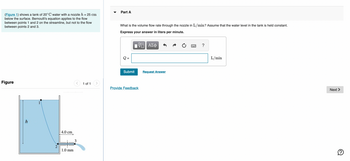
College Physics
11th Edition
ISBN: 9781305952300
Author: Raymond A. Serway, Chris Vuille
Publisher: Cengage Learning
expand_more
expand_more
format_list_bulleted
Concept explainers
Topic Video
Question
please answer

Transcribed Image Text:**Title: Understanding Fluid Flow Through a Nozzle Using Bernoulli's Equation**
**Description:**
This educational module explains the application of Bernoulli's equation to determine the flow rate of water through a nozzle in a tank. The example provided involves water at 20°C, which flows through a nozzle located 25 cm below the water surface in the tank. The goal is to find the volume flow rate in liters per minute (L/min).
**Diagram Explanation:**
- **Figure 1** illustrates a tank filled with water.
- The water surface is marked, with a point labeled "1" directly below it.
- The nozzle is positioned 25 cm below this surface, where a point labeled "2" marks the entrance to the nozzle.
- Point "3" is shown at the nozzle's exit, featuring a vertical pipe extending from the tank.
**Measurements in the Diagram:**
- The vertical distance from the surface to the nozzle is indicated as \( h = 25 \, \text{cm} \).
- The horizontal distance to the edge of the accompanying pipe extends 4.0 cm.
- The diameter of the pipe at the nozzle's exit is 1.0 mm.
**Problem Statement (Part A):**
Determine the volume flow rate through the nozzle in L/min, assuming a constant water level in the tank.
**Instructions for Calculation:**
1. Apply Bernoulli’s equation to the streamline between points 1 and 2, where the equation is applicable.
2. Use the properties of fluid flow and dimensions provided to calculate the desired volume flow rate.
**Interactive Component:**
An input box is provided for students to enter their calculated flow rate (Q) in liters per minute, followed by a "Submit" button for feedback on their answer.
**Additional Resources:**
- A link to provide feedback or request further clarification on the topic.
Expert Solution
This question has been solved!
Explore an expertly crafted, step-by-step solution for a thorough understanding of key concepts.
This is a popular solution
Trending nowThis is a popular solution!
Step by stepSolved in 4 steps

Knowledge Booster
Learn more about
Need a deep-dive on the concept behind this application? Look no further. Learn more about this topic, physics and related others by exploring similar questions and additional content below.Similar questions
- 3. Describe how a conductor acquires a charge.arrow_forwardFile 2 Undo A2 22 5 6 7 8 9 10 11 12 13 14 15 16 17 18 19 20 21 Home Insert A B 1 Charge (C) Magnitue (N) 2 0.02 449.378 3 0.028 229.274 4 0.036 138.677 0.044 92.847 0.052 66.476 0.06 49.931 0.068 38.873 0.076 31.12 0.084 25.475 0.092 21.237 0.1 17.975 22 Paste XAY Clipboard 5 V X✓ Sheet1 Page Layout Calibri B I U- C 0.02 D Force magnitude (N) Formulas Data Review View Font 500 450 400 350 300 250 200 150 100 50 0 0 11 - AA a A V E F 0.02 5 229.274 G 138.677 92.847 0.04 Help Series1 44995ce magnitude (N) vs Distance(m) M Alignment H →= y=0.1798x2 R² = 1 0.06 Distance (m) General 0.08 $ % 98 Power (Series1) 66.47649.9338.87331.1225.47221.2377.975 J Number 0.1 K 0.12 5arrow_forwardListen Add 9 micro Coulombs and 7,781 nano Coulombs and get the result in nano Coulombs unit. Your Answer: Answer units P Type here to search delete home 4- つ % & + backspace Icok $ 4 %3D %23 6. 7 8 1 P Y home W E R tab enter すarrow_forward
- A positive charge of 0.00018 C is 6 M from a negative charge of 0.00081 C. What is the force of one of the charges due to the other charge in units of Newtons? Round to 5 decimal places.arrow_forwardAn electrical appliance use 99 V and its resistance is 7,418 Q. How many electrons pass through the appliance every minute? Answer format: 1.2e+20. (e+20 is same as x10^20)arrow_forwardwhy there is 2pi?arrow_forward
arrow_back_ios
arrow_forward_ios
Recommended textbooks for you
 College PhysicsPhysicsISBN:9781305952300Author:Raymond A. Serway, Chris VuillePublisher:Cengage Learning
College PhysicsPhysicsISBN:9781305952300Author:Raymond A. Serway, Chris VuillePublisher:Cengage Learning University Physics (14th Edition)PhysicsISBN:9780133969290Author:Hugh D. Young, Roger A. FreedmanPublisher:PEARSON
University Physics (14th Edition)PhysicsISBN:9780133969290Author:Hugh D. Young, Roger A. FreedmanPublisher:PEARSON Introduction To Quantum MechanicsPhysicsISBN:9781107189638Author:Griffiths, David J., Schroeter, Darrell F.Publisher:Cambridge University Press
Introduction To Quantum MechanicsPhysicsISBN:9781107189638Author:Griffiths, David J., Schroeter, Darrell F.Publisher:Cambridge University Press Physics for Scientists and EngineersPhysicsISBN:9781337553278Author:Raymond A. Serway, John W. JewettPublisher:Cengage Learning
Physics for Scientists and EngineersPhysicsISBN:9781337553278Author:Raymond A. Serway, John W. JewettPublisher:Cengage Learning Lecture- Tutorials for Introductory AstronomyPhysicsISBN:9780321820464Author:Edward E. Prather, Tim P. Slater, Jeff P. Adams, Gina BrissendenPublisher:Addison-Wesley
Lecture- Tutorials for Introductory AstronomyPhysicsISBN:9780321820464Author:Edward E. Prather, Tim P. Slater, Jeff P. Adams, Gina BrissendenPublisher:Addison-Wesley College Physics: A Strategic Approach (4th Editio...PhysicsISBN:9780134609034Author:Randall D. Knight (Professor Emeritus), Brian Jones, Stuart FieldPublisher:PEARSON
College Physics: A Strategic Approach (4th Editio...PhysicsISBN:9780134609034Author:Randall D. Knight (Professor Emeritus), Brian Jones, Stuart FieldPublisher:PEARSON

College Physics
Physics
ISBN:9781305952300
Author:Raymond A. Serway, Chris Vuille
Publisher:Cengage Learning

University Physics (14th Edition)
Physics
ISBN:9780133969290
Author:Hugh D. Young, Roger A. Freedman
Publisher:PEARSON

Introduction To Quantum Mechanics
Physics
ISBN:9781107189638
Author:Griffiths, David J., Schroeter, Darrell F.
Publisher:Cambridge University Press

Physics for Scientists and Engineers
Physics
ISBN:9781337553278
Author:Raymond A. Serway, John W. Jewett
Publisher:Cengage Learning

Lecture- Tutorials for Introductory Astronomy
Physics
ISBN:9780321820464
Author:Edward E. Prather, Tim P. Slater, Jeff P. Adams, Gina Brissenden
Publisher:Addison-Wesley

College Physics: A Strategic Approach (4th Editio...
Physics
ISBN:9780134609034
Author:Randall D. Knight (Professor Emeritus), Brian Jones, Stuart Field
Publisher:PEARSON